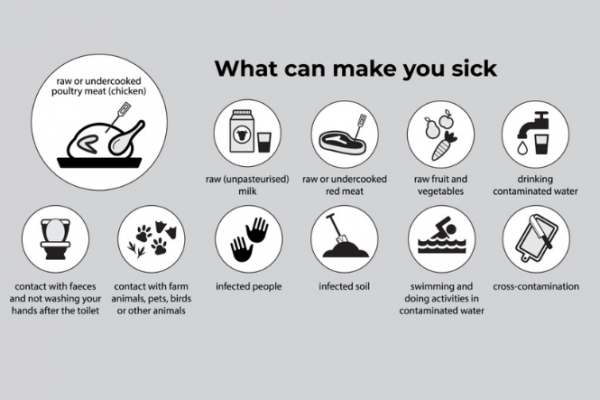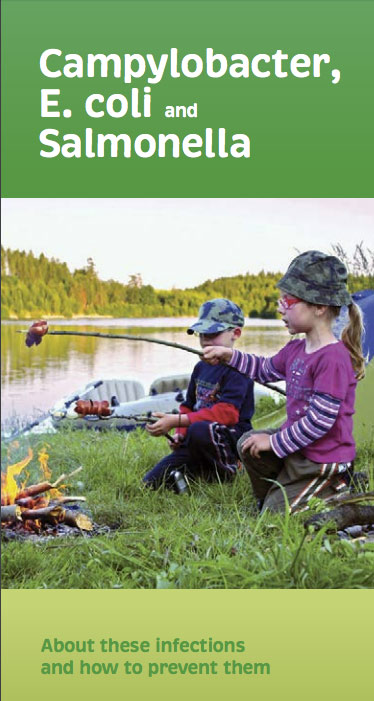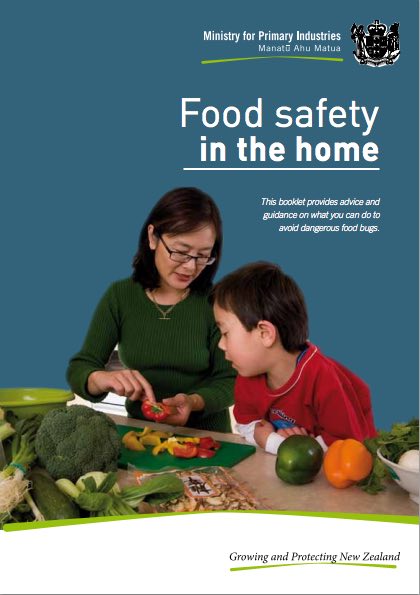Wishing everyone a safe and happy Christmas and New Year – Meri Kirihimete from the Healthify team.
Campylobacter
Pronounced cam-pile-oh-bacter
Key points about campylobacter
- Campylobacter infection is a type of gastroenteritis (‘food poisoning’) that is caused by the Campylobacter bacteria (germ).
- It's mainly spread to humans by eating undercooked contaminated meat and is a common cause of tummy upsets, diarrhoea and stomach pains.
- People and animals can carry and spread the infection even if they don’t have symptoms.

Campylobacter infection is a type of gastroenteritis (‘food poisoning’) that's caused by the Campylobacter bacteria (germ).
It's mainly spread to by eating undercooked contaminated meat, especially chicken, and is a common cause of tummy upsets, diarrhoea and stomach pains.
Most people recover without needing any special medicines. You can help your recovery by drinking plenty of fluids to avoid getting dehydrated.
Practising good hand hygiene and taking care when preparing food can help prevent the spread of campylobacter.
The typical symptoms are:
- stomach pain or cramps, which may be severe
- diarrhoea (runny poo) which may have blood in it
- nausea (feeling sick) or vomiting (being sick).
Other symptoms may include a flu-like illness first, eg, headache, muscle pains, fever and feeling very tired.
Symptoms will usually appear 2 to 5 days after exposure.
- Some people will have mild symptoms only or none at all.
- Most people with campylobacter infection recover from the illness within 1 week, but symptoms can last for up to 10 days.
- In serious cases, complications can occur including dehydration and bloodstream infection.
- Long-term problems are rare, but may include irritable bowel syndrome, arthritis or acute paralysis (Guillain-Barre syndrome).
Campylobacter bacteria are found in the faeces (poo) of many animals, including farm animals and household pets. People and animals can carry and spread the infection even if they don’t have symptoms. Campylobacter bacteria is often spread to humans in the following ways:
- Eating contaminated food: This includes undercooked meat, especially chicken, or contaminated raw fruit and vegetables. Contamination of food can also happen when hands are not washed properly after going to the toilet or changing the nappy of an infected infant.
- Cross-contamination: Campylobacter can spread in the kitchen by cross-contamination from raw chicken meat, including juices from the meat, to other food, utensils (eg, chopping boards), food contact surfaces and the hands and clothing of food handlers. It can also spread to other surfaces, eg, toys, bathroom taps or doors, and nappy change tables.
- Drinking contaminated water: This includes contaminated water from sewage outflow systems, waste run-off from grazed pasture and poo from wild birds.
- Direct handling of animals: As campylobacter bacteria are found in animal poo, it can be spread by handling infected animals and not washing your hands afterwards.
- Swimming or playing in contaminated ‘recreational water’ (eg, contaminated rivers and lakes).

Image credit: Ministry for Primary Industries, NZ
Who is most at risk of campylobacter infection?
- Travellers to developing countries where sanitation and food hygiene may be less strict.
- Farm workers, meat processing workers and those who handle raw meat may be more likely to be exposed to the bacteria.
- Those at higher risk of serious infection are young children, older people and those with other serious health conditions.
Most cases of gastro don't require special investigations. If your symptoms are severe or ongoing, or your healthcare provider suspects you might have campylobacter, you may be asked to provide a stool (poo) sample. This can be tested in the laboratory for campylobacter and other bacteria.
Campylobacter is a notifiable disease. This means that if you are found to have campylobacter, your healthcare provider will notify the Public Health Service. Someone from your local public health team may contact you to find out how you picked up the bacteria. This helps them trace the source of infection to reduce the risk of a large outbreak.
Most people will recover without the need for any special medicines. You can help your recovery by drinking plenty of fluids to avoid getting dehydrated. Take extra care with young children and older adults who can become dehydrated very quickly. Also, eat as you feel able – be guided by your appetite. Start with bland foods (eg, toast or rice) and small, light meals.
Antibiotics
Antibiotics are not commonly needed to treat campylobacter infections. They have little impact on how long you are sick or how severe your symptoms are. They may help prevent the spread of the disease by killing the bacteria in your poo. Antibiotics may be considered when symptoms are severe or prolonged, or for people at high risk of complications, eg, pregnant women or people with weakened immune systems.
Medicines for diarrhoea
Medicines for diarrhoea (eg, loperamide and Diastop®) are not routinely recommended, but may be considered in some circumstances. They must be avoided if you have blood and mucous in your poo. This can make things worse as it can make your diarrhoea last longer and there is the risk of a serious complication – toxic megacolon. Medicines for diarrhoea are also not recommended for children under 12 years of age. Before taking them, check with your healthcare provider whether they're safe for you.
Although campylobacter doesn't usually spread from one person to another, it can be spread through contact with contaminated food, surfaces and water. You can be infectious for 2 to 7 weeks from the start of your illness.
To reduce the risk of spreading the infection:
- Avoid preparing food for other people. If you must do so, wash and dry your hands well first.
- Stay away from school, early childhood centres or work, and community gatherings.
- You can usually go back to work (early childhood centres and school) if you've have been free of symptoms for 24 to 48 hours. However, as campylobacter infection is a notifiable disease (see the diagnosis section above) you will need to check with your healthcare provider first.
- If you work in a hospital, rest home, school, early childhood centre, or your job involves handling food, you may be required to stay away from work for 48 hours (2 days) after your symptoms have stopped.
- Don’t go swimming in a pool if you have diarrhoea. You need to wait at least 2 weeks after the symptoms have gone.
- If you or a child are unwell then don't share bathwater, as this can easily transmit infection.
Practice good hygiene
Campylobacter can be carried on your hands so it's important to wash your hands thoroughly with soap and warm water after going to the toilet, after changing infants in nappies, before handling and eating food, after handling raw food (especially raw poultry), after gardening and after contact with pets and other animals. Read more about hygiene and hand washing.
Food preparation
Take care when preparing food, cook food well, watch what you eat and wash your hands frequently and properly. Use different chopping boards, trays, utensils and plates when preparing raw foods and ready-to-eat food. If you only have 1 chopping board, wash it well in hot soapy water before using it again.
- Clean all food preparation areas, utensils and equipment. Wash raw vegetables properly.
- Cook raw foods well and cook leftovers until steaming hot. Make sure minced meat, chicken and sausages are cooked thoroughly until juices are clear. Thorough cooking of food kills Campylobacter.
- Cover all foods in the fridge, cupboard and outdoors. Separate and store raw and cooked foods so there's no chance of cross-contamination.
- Chill and store ready-to-eat food between 0–4°C. Any leftover cooked food should be covered and chilled (within 2 hours).
Read more about food safety.
If your water source is believed to be contaminated, you must boil all water(external link) for 1 minute before drinking, making up infant formula and using in food preparation and for cleaning teeth. Read more about Campylobacter, E.Coli and Salmonella.(external link)
The following links provide further information about campylobactor. Be aware that websites from other countries may have information that differs from New Zealand recommendations.
Campylobacter, E.Coli and Salmonella(external link) HealthEd, NZ
Campylobacter infections(external link)(external link) Centers for Disease Control and Prevention
Campylobacter infection – symptoms and advice(external link) Ministry for Primary Industries, NZ
Resources
Campylobacter, E coli & salmonella(external link) HealthEd, NZ
Food safety in the home(external link) Ministry for Primary Industries, NZ
Household water supplies(external link) Taumata Arowai NZ
Meet the bugs(external link) Ministry of Primary Industries, NZ
References
- Campylobacter(external link) NZ Food Safety, August 2018
- Food and water borne diseases(external link) Health New Zealand | Te Whatu Ora
- Investigating and managing people with diarrhoea(external link) BPAC, NZ, 2014
- Campylobacter(external link) Health New Zealand | Te Whatu Ora, NZ
- Campylobacter(external link) Health Info, NZ, 2022
- Campylobacter, E.Coli and Salmonella(external link) HealthEd, NZ
- Infectious gastroenteritis(external link) Auckland Region HealthPathways, NZ, 2023 (login required)
If antibiotics are needed for campylobacter, the first choice is erythromycin:
- Child: 10 mg/kg/dose, four times daily, for five days.
- Adult: 400 mg, four times daily, for five days.
More information: Antibiotics guide, gastrointestinal section(external link) BPAC, NZ, 2017
Laboratory investigation of infectious diarrhoea(external link) BPAC, NZ, 2012
Assessment and management of infectious diarrhoea(external link) BPAC, NZ, 2009
Schedule of notifiable diseases(external link) Ministry of Health, NZ, 2023
Brochures

HealthEd, NZ, 2023

Ministry for Primary Industries, NZ, 2021

Ministry of Primary Industries, NZ, 2017
Credits: Healthify editorial team. Healthify is brought to you by Health Navigator Charitable Trust.
Last reviewed:





